|
|
|
Sort Order |
|
|
|
Items / Page
|
|
|
|
|
|
|
| Srl | Item |
| 1 |
ID:
030799
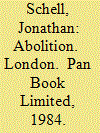

|
|
|
|
|
| Publication |
London, Pan Book Limited, 1984.
|
| Description |
170p.
|
| Standard Number |
0330287028
|
|
|
|
|
|
|
|
|
|
|
|
Copies: C:1/I:0,R:0,Q:0
Circulation
| Accession# | Call# | Current Location | Status | Policy | Location |
| 024850 | 341.734/SCH 024850 | Main | On Shelf | General | |
|
|
|
|
| 2 |
ID:
162700
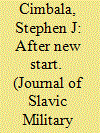

|
|
|
|
|
| Summary/Abstract |
The United States has planned an ambitious strategic nuclear modernization program, as has Russia. Within this context, what are the expectations for New START and its extension to 2026 or beyond? This study analyzes possible scenarios for US strategic nuclear modernization within New START limitations, acknowledging that wild cards include the fate of the INF treaty, threats posed by missile defenses and postmodern counter-defense weapons, and other uncertainties.
|
|
|
|
|
|
|
|
|
|
|
|
|
|
|
|
| 3 |
ID:
091402
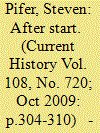

|
|
|
|
|
| Publication |
2009.
|
| Summary/Abstract |
The Obama administration regards a post-START treaty as the first step in a continuing process of nuclear arms reductions. But this will prove the last 'easy' nuclear arms control agreement between Washington and Moscow.
|
|
|
|
|
|
|
|
|
|
|
|
|
|
|
|
| 4 |
ID:
038309
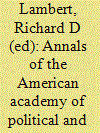

|
|
|
|
|
| Publication |
London, Sage Publications, 1983.
|
| Description |
v.469 (213p.)
|
| Contents |
Vol.469: Nuclear armament and disarmament
|
| Standard Number |
0803921144
|
|
|
|
|
|
|
|
|
|
|
|
Copies: C:1/I:0,R:0,Q:0
Circulation
| Accession# | Call# | Current Location | Status | Policy | Location |
| 022554 | 355.825119/LAM 022554 | Main | On Shelf | General | |
|
|
|
|
| 5 |
ID:
152945
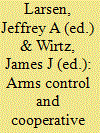

|
|
|
|
|
| Publication |
New Delhi, Viva Books, 2011.
|
| Description |
xiv, 288p.hbk
|
| Standard Number |
9788130915302
|
|
|
|
|
|
|
|
|
|
|
|
Copies: C:1/I:0,R:0,Q:0
Circulation
| Accession# | Call# | Current Location | Status | Policy | Location |
| 059059 | 355.02/LAR 059059 | Main | On Shelf | General | |
|
|
|
|
| 6 |
ID:
034040
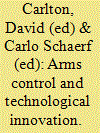

|
|
|
|
|
| Publication |
London, Croom Helm, 1977.
|
| Description |
366p.
|
| Standard Number |
0856644439
|
|
|
|
|
|
|
|
|
|
|
|
Copies: C:2/I:0,R:0,Q:0
Circulation
| Accession# | Call# | Current Location | Status | Policy | Location |
| 017547 | 327.174/CAR 017547 | Main | On Shelf | General | |
| 021750 | 327.174/CAR 021750 | Main | On Shelf | General | |
|
|
|
|
| 7 |
ID:
034068
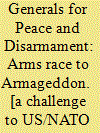

|
|
|
|
|
| Publication |
Warwickshire, Berg Publishers, 1984.
|
| Description |
vii, 151p.
|
| Standard Number |
0907582265
|
|
|
|
|
|
|
|
|
|
|
|
Copies: C:1/I:0,R:0,Q:0
Circulation
| Accession# | Call# | Current Location | Status | Policy | Location |
| 025203 | 355.0217/ARM 025203 | Main | On Shelf | General | |
|
|
|
|
| 8 |
ID:
026991
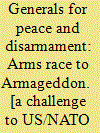

|
|
|
|
|
| Publication |
Worwickshire, Berg Publishers, 1984.
|
| Description |
vii, 151p.
|
|
|
|
|
|
|
|
|
|
|
|
Copies: C:1/I:0,R:0,Q:0
Circulation
| Accession# | Call# | Current Location | Status | Policy | Location |
| 025221 | 355.0217/GEN 025221 | Main | On Shelf | General | |
|
|
|
|
| 9 |
ID:
079412
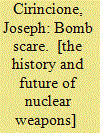

|
|
|
|
|
| Publication |
New York, Columbia University, 2007.
|
| Description |
xiv, 206p.
|
| Standard Number |
9780231135108
|
|
|
|
|
|
|
|
|
|
|
|
Copies: C:1/I:0,R:0,Q:0
Circulation
| Accession# | Call# | Current Location | Status | Policy | Location |
| 052759 | 355.0217/CIR 052759 | Main | On Shelf | General | |
|
|
|
|
| 10 |
ID:
091243
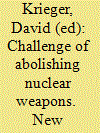

|
|
|
|
|
| Publication |
New Brunswick, Transaction Publishers, 2009.
|
| Description |
xxvi, 281p.
|
| Standard Number |
9781412810364
|
|
|
|
|
|
|
|
|
|
|
|
Copies: C:1/I:0,R:0,Q:0
Circulation
| Accession# | Call# | Current Location | Status | Policy | Location |
| 054370 | 327.1747/KRI 054370 | Main | On Shelf | General | |
|
|
|
|
| 11 |
ID:
097943
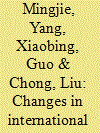

|
|
|
| 12 |
ID:
174874
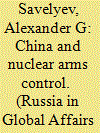

|
|
|
|
|
| Summary/Abstract |
Beijing explains its firm unwillingness to join the United States and Russia in nuclear arms control talks by the fact that China’s nuclear arsenal is incomparable with respective potentials of the world’s two leading nuclear powers. China urges Russia and the U.S. to go ahead with the nuclear disarmament process on a bilateral basis, and promises it will be prepared to consider the possibility of its participation in the negotiations only when its counterparts have downgraded their arsenals approximately to China’s level. Washington finds this totally unacceptable and demands that China either join the existing Russian-U.S. strategic New START treaty right away or agree to enter into a trilateral nuclear arms control format. This article studies the prospects of China’s involvement in nuclear arms talks and analyzes the true reasons behind Beijing’s desire to avoid any nuclear disarmament deals at this point. The working hypothesis of this paper is that China’s stance on the above issue is by no means far-fetched or propagandistic, and that it is driven by fundamental political, military and strategic considerations. Disregard for this factor and further forceful efforts to bring China to the negotiating table to discuss nuclear arms control will lead to failure.
|
|
|
|
|
|
|
|
|
|
|
|
|
|
|
|
| 13 |
ID:
054526
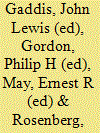

|
|
|
|
|
| Publication |
Oxford, Oxford University Press, 1999.
|
| Description |
ix, 398p.
|
| Standard Number |
0198294689
|
|
|
|
|
|
|
|
|
|
|
|
Copies: C:1/I:0,R:0,Q:0
Circulation
| Accession# | Call# | Current Location | Status | Policy | Location |
| 041413 | 355.825119/GAD 041413 | Main | On Shelf | General | |
|
|
|
|
| 14 |
ID:
115972
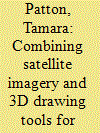

|
|
|
|
|
| Publication |
2012.
|
| Summary/Abstract |
The ability to extract three-dimensional (3D) data from two-dimensional satellite images provides opportunities to apply novel geospatial techniques to problems relating to nuclear arms control, nonproliferation, and disarmament. This study demonstrates some of these techniques by estimating the plutonium production capacity of the heavy water nuclear reactors at the Khushab complex in Pakistan, where since 1998 Pakistan has produced plutonium for its nuclear arsenal. Three-dimensional analysis is used to assess the viability of using the horizontal cross-sectional area of the Khushab reactors' mechanical draft cooling towers to estimate the thermal capacity of each reactor and set an upper bound for the reactors' abilities to produce plutonium. The horizontal area approach suggests the three completed Khushab reactors have a thermal power of 40-90 MWt each. The results suggest that a horizontal area approach can be used successfully with the Khushab reactors, as well as other low power, research-type reactors employing mechanical draft cooling towers.
|
|
|
|
|
|
|
|
|
|
|
|
|
|
|
|
| 15 |
ID:
026287
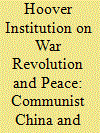

|
|
|
|
|
| Publication |
Stanford, Stanford University, 1968.
|
| Description |
viii, 181p.
|
|
|
|
|
|
|
|
|
|
|
|
Copies: C:1/I:0,R:0,Q:0
Circulation
| Accession# | Call# | Current Location | Status | Policy | Location |
| 001692 | 327.51073/HOO 001692 | Main | On Shelf | General | |
|
|
|
|
| 16 |
ID:
101601
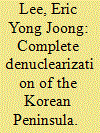

|
|
|
|
|
| Publication |
2010.
|
| Summary/Abstract |
The primary purpose of this article is to propose general conditions for establishing a nuclear weapon-free zone (NWFZ) in the Korean Peninsula from the viewpoint of international law. North Korea's nuclear weapons development has created the most negative environment for the peace and security of Northeast Asia since the early 1990s. In spite of painstaking negotiations to denuclearize North Korea, the parties concerned have not found any fundamental solution yet. This interim failure is due to the uncompromising positions of the two sides as well as the inherently paradoxical structure of the Treaty on the Non-Proliferation of Nuclear Weapons, which legalizes the development of nuclear weapons by the recognized nuclear powers. The most reasonable solution is to completely and fairly denuclearize the whole Korean Peninsula under an NWFZ. This paper scrutinizes legal, political and technical problems for realizing the plan for a nuclear-free Korean Peninsula.
|
|
|
|
|
|
|
|
|
|
|
|
|
|
|
|
| 17 |
ID:
123223
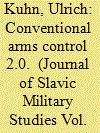

|
|
|
|
|
| Publication |
2013.
|
| Summary/Abstract |
For more than a decade Europe's once unique arms control acquis is in decline. This pertains foremost to conventional arms control. An assessment of current political North Atlantic Treaty Organization (NATO)-Russia problems and military insecurities on the continent shows that a modern approach to conventional arms control could positively contribute to security and stability. In times of financial austerity, a new framework has to focus on mutual military reassurances, transparency, conflict prevention, and the links to nuclear arms control. To achieve such a goal, U.S. leadership, as well as Europeanization of the Reset policy, is needed.
|
|
|
|
|
|
|
|
|
|
|
|
|
|
|
|
| 18 |
ID:
049709
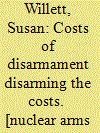

|
|
|
|
|
| Publication |
Geneva, United Nations Institute for Disarmament Research, 2003.
|
| Description |
xvii, 33333156p.
|
| Standard Number |
9290451548
|
|
|
|
|
|
|
|
|
|
|
|
Copies: C:1/I:0,R:0,Q:0
Circulation
| Accession# | Call# | Current Location | Status | Policy | Location |
| 047338 | 327.174/WIL 047338 | Main | On Shelf | General | |
|
|
|
|
| 19 |
ID:
146737
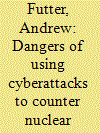

|
|
|
|
|
| Contents |
Top military and defense officials in the United States are currently contemplating plans to use cyberattack capabilities against enemy missile and command-and-control systems as part of a new push for full-spectrum missle defense.
|
|
|
|
|
|
|
|
|
|
|
|
|
|
|
|
| 20 |
ID:
085126
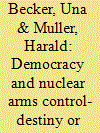

|
|
|
|
|
| Publication |
2008.
|
| Summary/Abstract |
Is there a particularly democratic way of dealing with nuclear arms control? Against the background of democratic peace (DP) theory, and using Immanuel Kant's writing as a starting point, this article argues that democracies should indeed develop a preference for arms control, but that Liberalism as well as the nature of nuclear weapons opens the possibility for contingent developments within a DP framework. While DP theory can thus account for the existence of variance, we maintain that a social constructivist complement based on role, identity, and enemy perception can best explain why a given democracy follows a specific path. Case studies of six Western democracies reveal a considerable variance in their nuclear arms control policies, which can indeed be traced back to the countries' respective roles, identities, and images of the Kantian "unjust enemy."
|
|
|
|
|
|
|
|
|
|
|
|
|
|
|
|
|
|
|
|
|